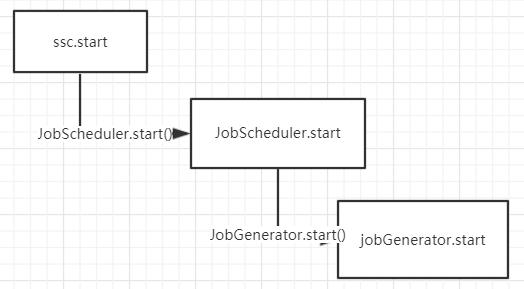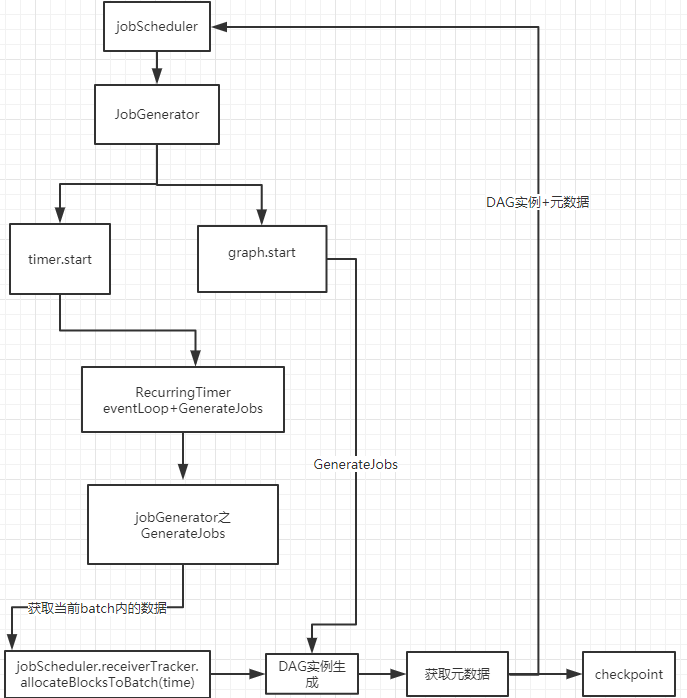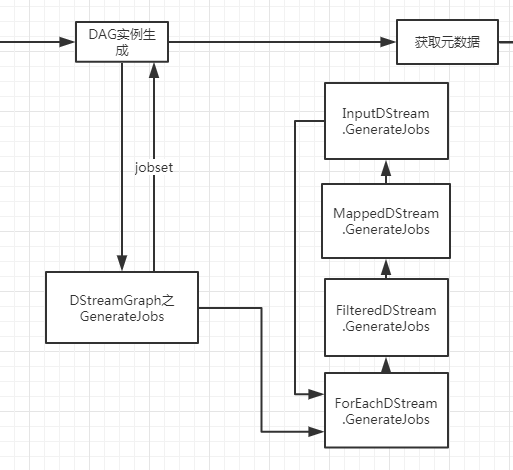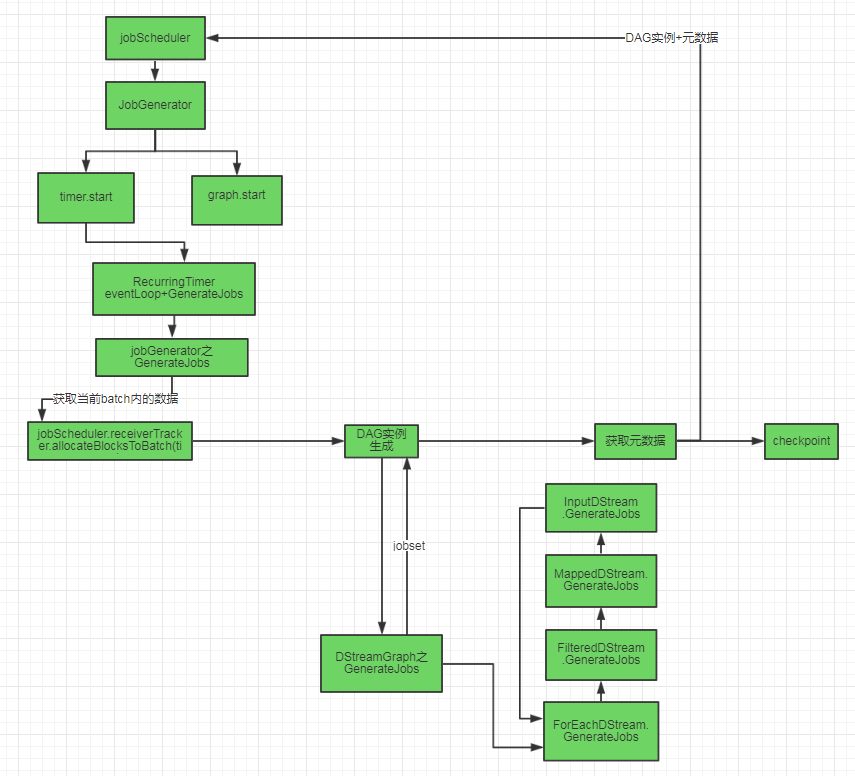spark streaming之三 rdd,job的动态生成以及动态调度
前面一篇讲到了,DAG静态模板的生成。那么spark streaming会在每一个batch时间一到,就会根据DAG所形成的逻辑以及物理依赖链(dependencies)动态生成RDD以及由这些RDD组成的job,并形成一个job集合提交到集群当中执行。那么下面我们具体分析这三个步骤。
首先从JobScheduler讲起。在本节所需要了解的是JobScheduler的两个重要对象。jobExecutor与JobHandler。jobExecutor是一个名为streaming-job-executor的线程池,JobHandler是一个继承自Runnable的线程类。提交过来的JOB将提交到到这里执行。
private val jobExecutor =
ThreadUtils.newDaemonFixedThreadPool(numConcurrentJobs, "streaming-job-executor")
private class JobHandler(job: Job) extends Runnable with Logging {
import JobScheduler._
def run() {
val oldProps = ssc.sparkContext.getLocalProperties
try {
ssc.sparkContext.setLocalProperties(SerializationUtils.clone(ssc.savedProperties.get()))
val formattedTime = UIUtils.formatBatchTime(
job.time.milliseconds, ssc.graph.batchDuration.milliseconds, showYYYYMMSS = false)
val batchUrl = s"/streaming/batch/?id=${job.time.milliseconds}"
val batchLinkText = s"[output operation ${job.outputOpId}, batch time ${formattedTime}]"
ssc.sc.setJobDescription(
s"""Streaming job from <a href="$batchUrl">$batchLinkText</a>""")
ssc.sc.setLocalProperty(BATCH_TIME_PROPERTY_KEY, job.time.milliseconds.toString)
ssc.sc.setLocalProperty(OUTPUT_OP_ID_PROPERTY_KEY, job.outputOpId.toString)
// Checkpoint all RDDs marked for checkpointing to ensure their lineages are
// truncated periodically. Otherwise, we may run into stack overflows (SPARK-6847).
ssc.sparkContext.setLocalProperty(RDD.CHECKPOINT_ALL_MARKED_ANCESTORS, "true")
// We need to assign `eventLoop` to a temp variable. Otherwise, because
// `JobScheduler.stop(false)` may set `eventLoop` to null when this method is running, then
// it's possible that when `post` is called, `eventLoop` happens to null.
var _eventLoop = eventLoop
if (_eventLoop != null) {
_eventLoop.post(JobStarted(job, clock.getTimeMillis()))
// Disable checks for existing output directories in jobs launched by the streaming
// scheduler, since we may need to write output to an existing directory during checkpoint
// recovery; see SPARK-4835 for more details.
PairRDDFunctions.disableOutputSpecValidation.withValue(true) {
job.run()
}
_eventLoop = eventLoop
if (_eventLoop != null) {
_eventLoop.post(JobCompleted(job, clock.getTimeMillis()))
}
} else {
// JobScheduler has been stopped.
}
} finally {
ssc.sparkContext.setLocalProperties(oldProps)
}
}
}
}
另外两个需要了解的对象,jobGenerator以及receiverTracker。jobGenerator负责job的动态生成,receiverTracker负责数据源的接收以及接收以后的transformation,以及根据这些转换形成DAG模板。随着JobScheduler启动的时候,jobGenerator以及receiverTracker也将启动。
def start(): Unit = synchronized {
if (eventLoop != null) return // scheduler has already been started
logDebug("Starting JobScheduler")
eventLoop = new EventLoop[JobSchedulerEvent]("JobScheduler") {
override protected def onReceive(event: JobSchedulerEvent): Unit = processEvent(event)
override protected def onError(e: Throwable): Unit = reportError("Error in job scheduler", e)
}
eventLoop.start()
// attach rate controllers of input streams to receive batch completion updates
for {
inputDStream <- ssc.graph.getInputStreams
rateController <- inputDStream.rateController
} ssc.addStreamingListener(rateController)
listenerBus.start()
receiverTracker = new ReceiverTracker(ssc)
inputInfoTracker = new InputInfoTracker(ssc)
val executorAllocClient: ExecutorAllocationClient = ssc.sparkContext.schedulerBackend match {
case b: ExecutorAllocationClient => b.asInstanceOf[ExecutorAllocationClient]
case _ => null
}
executorAllocationManager = ExecutorAllocationManager.createIfEnabled(
executorAllocClient,
receiverTracker,
ssc.conf,
ssc.graph.batchDuration.milliseconds,
clock)
executorAllocationManager.foreach(ssc.addStreamingListener)
receiverTracker.start()//
jobGenerator.start()//
executorAllocationManager.foreach(_.start())
logInfo("Started JobScheduler")
}

JobGenerator 启动
本节先按下 receiverTracker不表。先说jobGenerator。我们首先来看看它的start函数。首先启动一个待命的线程。然后根据上次的spark streaming任务是否执行了checkpoint来决定是执行restart()还是startFirstTime()。
/** Start generation of jobs */
def start(): Unit = synchronized {
......
eventLoop.start() if (ssc.isCheckpointPresent) {
restart()
} else {
startFirstTime()
}
}
因为只为弄清流程原理,我们只看第一次启动的情况。
/** Starts the generator for the first time */
private def startFirstTime() {
val startTime = new Time(timer.getStartTime())
graph.start(startTime - graph.batchDuration)
timer.start(startTime.milliseconds)
logInfo("Started JobGenerator at " + startTime)
}
首先graph.start(startTime - graph.batchDuration)传递一个时间参数给DStreamGraph,告知其batch启动时间,并初始化相关参数。然后启动定时器。
RecurringTimer
代码如下
private val timer = new RecurringTimer(clock, ssc.graph.batchDuration.milliseconds,
longTime => eventLoop.post(GenerateJobs(new Time(longTime))), "JobGenerator")
其实就是往eventLoop线程里加入GenerateJobs。即定时根据DAG模板生成当前batch的DAG实例。注意这里是jobGenerator的GenerateJobs。
jobGenerator之GenerateJobs
/** Generate jobs and perform checkpointing for the given `time`. */
private def generateJobs(time: Time) {
SparkEnv.set(ssc.env)
Try {
jobScheduler.receiverTracker.allocateBlocksToBatch(time)
graph.generateJobs(time)
} match {
case Success(jobs) =>
val streamIdToInputInfos = jobScheduler.inputInfoTracker.getInfo(time)
jobScheduler.submitJobSet(JobSet(time, jobs, streamIdToInputInfos))
case Failure(e) =>
jobScheduler.reportError("Error generating jobs for time " + time, e)
}
eventLoop.post(DoCheckpoint(time, clearCheckpointDataLater = false))
}
它做了五件事情。
首先,通知jobScheduler获取当前batch需要处理的数据。
然后调用DStreamGraph的GenerateJobs函数真正去执行操作。
第三,将第一步获取到的数据保存在inputInfoTracker中。这部份被称之为元数据。什么叫元数据,就是最开始没有经过各种转换的数据。
第四,将生成的RDD实例以及元数据一同提交给jobScheduler。这部份是提交到jobExecutor这个线程池里异步执行的。
再然后后将一个checkpoint任务异步交给eventLoop去执行。
InputinfoTracker
可能有人会发现上面的表述中,第一和第三步有点雷同。但其实它们是不一样的。
我们追踪jobScheduler.receiverTracker.allocateBlocksToBatch(time)最终得到的数据结构为:
private[streaming] case class ReceivedBlockInfo(
streamId: Int,
numRecords: Option[Long],
metadataOption: Option[Any],
blockStoreResult: ReceivedBlockStoreResult
)
jobScheduler.inputInfoTracker.getInfo(time)最终得到的数据结构为:
case class StreamInputInfo(
inputStreamId: Int, numRecords: Long, metadata: Map[String, Any] = Map.empty) {
require(numRecords >= 0, "numRecords must not be negative") def metadataDescription: Option[String] =
metadata.get(StreamInputInfo.METADATA_KEY_DESCRIPTION).map(_.toString)
}
对比发现,两种数据结构都有streamId(inputStreamId),numRecords,metadataOption,区别在于blockStoreResult。而且第三步获取到的元数据有句注释:Map to track all the InputInfo related to specific batch time and input stream。意为跟踪所有输入流信息和处理记录号的跟踪器。
// Map to track all the InputInfo related to specific batch time and input stream.
private val batchTimeToInputInfos =
new mutable.HashMap[Time, mutable.HashMap[Int, StreamInputInfo]]
InputInfoTracker的注释是This class manages all the input streams as well as their input data statistics. The information will be exposed through StreamingListener for monitoring.还有,StreamInputInfo注解为@DeveloperAPI。
我的理解是第一步所做的是获取到数据。第三步所做的是给这些数据加上属性,提供给开发者查询展示监控。
到目前为止,我们分析了动态调度的流程,整个流程如图:

DAG实例生成
上面仅仅是分析了动态调度的问题,而DAG实例究竟是怎样生成的?

总结

到这里为止,我们根据DAG模板拿到了DAG实例,以及数据。那么接下来,会根据DAGScheduler划分task,stage。
spark streaming之三 rdd,job的动态生成以及动态调度的更多相关文章
- Spark streaming技术内幕6 : Job动态生成原理与源码解析
原创文章,转载请注明:转载自 周岳飞博客(http://www.cnblogs.com/zhouyf/) Spark streaming 程序的运行过程是将DStream的操作转化成RDD的操作,S ...
- Spark Streaming中空RDD处理及流处理程序优雅的停止
本期内容 : Spark Streaming中的空RDD处理 Spark Streaming程序的停止 由于Spark Streaming的每个BatchDuration都会不断的产生RDD,空RDD ...
- Spark Streaming之三:DStream解析
DStream 1.1基本说明 1.1.1 Duration Spark Streaming的时间类型,单位是毫秒: 生成方式如下: 1)new Duration(milli seconds) 输入毫 ...
- Spark Streaming源码解读之Receiver生成全生命周期彻底研究和思考
本期内容 : Receiver启动的方式设想 Receiver启动源码彻底分析 多个输入源输入启动,Receiver启动失败,只要我们的集群存在就希望Receiver启动成功,运行过程中基于每个Tea ...
- IDEA Spark Streaming 操作(RDD队列流)
import org.apache.spark.SparkConf import org.apache.spark.rdd.RDD import org.apache.spark.streaming. ...
- 解读Spark Streaming RDD的全生命周期
本节主要内容: 一.DStream与RDD关系的彻底的研究 二.StreamingRDD的生成彻底研究 Spark Streaming RDD思考三个关键的问题: RDD本身是基本对象,根据一定时间定 ...
- Spark Streaming 实现思路与模块概述
一.基于 Spark 做 Spark Streaming 的思路 Spark Streaming 与 Spark Core 的关系可以用下面的经典部件图来表述: 在本节,我们先探讨一下基于 Spark ...
- 大数据技术之_19_Spark学习_04_Spark Streaming 应用解析 + Spark Streaming 概述、运行、解析 + DStream 的输入、转换、输出 + 优化
第1章 Spark Streaming 概述1.1 什么是 Spark Streaming1.2 为什么要学习 Spark Streaming1.3 Spark 与 Storm 的对比第2章 运行 S ...
- 2.Spark Streaming运行机制和架构
1 解密Spark Streaming运行机制 上节课我们谈到了技术界的寻龙点穴.这就像过去的风水一样,每个领域都有自己的龙脉,Spark就是龙脉之所在,它的龙穴或者关键点就是SparkStreami ...
随机推荐
- solr 学习笔记(一)--搜索引擎简介
一 搜索引擎是什么一套可对大量结构化.半结构化数据.非结构化文本类数据进行实时搜索的专门软件最早应用于信息检索领域,经谷歌.百度等公司推出网页搜索而为大众广知.后又被各大电商网站采用来做网站的商品搜索 ...
- 文件内容比较difflib
#!/usr/bin/env python#-*- coding:utf-8 -*-import difflibimport sys,osos.chdir('E:\\PythonWrok')a = o ...
- 使用FileZilla连接时超时,无法连接到服务器
更改一下加密方式,就是不用TLS,用相对不安全方式的(可选项) 腾讯云就是这样的,
- qsort函数排序各种类型的数据。
qsort函数是库函数中的一员,我们先来看看官方文档是怎么写的: 其中qsort的参数void* base是传入一个数组,size_t num 为数组整体大小,size_t size 为单个元素的大小 ...
- BIO、NIO实战
BIO BIO:blocking IO,分别写一个服务端和客户端交互的C/S实例.服务器端: import java.io.BufferedReader; import java.io.IOExcep ...
- zabbix之 自定义内存使用率监控报警
配置zabbix当内存剩余不足15%的时候触发报警 zabbix默认的剩余内存报警:Average Lack of available memory on server {HOST.NAME}{T ...
- NetCore2.0 CodeFirst 解析全国区划信息
NetCore2.0 数据库:SQLite HTML解析:HtmlAgilityPack 区划数据:http://www.stats.gov.cn/tjsj/tjbz/xzqhdm/201703/t2 ...
- 删除iis日志(deliislogs.vbs)
'path 目录 'ext 文件扩展名'expiredDays 保留多少天以内的文件Sub LogCleaner(path,ext,expiredDays) On Error Resume Next ...
- 解决双击excel文件打开多个excel.exe进程的问题
解决双击excel文件打开多个excel.exe进程的问题有些时候,双击两个excel文件,会打开多个excel进程,不同进程之间不能复制粘贴公式,只能粘贴数值,很不方便.怎么样双击多个excel文件 ...
- redis集群设置密码
redis集群密码设置 1.密码设置(推荐)方式一:修改所有Redis集群中的redis.conf文件加入: masterauth passwd123 requirepass passwd123 说 ...
